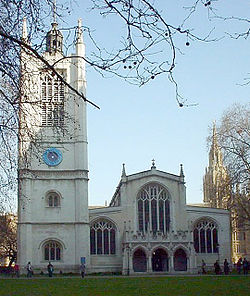St Margaret's, Westminster
| St Margaret's | |
|
Westminster, Middlesex | |
|---|---|
 St Margaret's Church, Westminster Abbey | |
| Church of England | |
| (Royal peculiar) | |
| Location | |
| Grid reference: | TQ30107949 |
| Location: | 51°29’58"N, 0°7’37"W |
| History | |
| Built 1486 to 1523 | |
| Information | |
The Church of St Margaret, Westminster Abbey, stands in the grounds of Westminster Abbey on Parliament Square. It stands opposite the Palace of Westminster and is commonly nicknamed "the parish church of the House of Commons".[1] It is dedicated to Margaret of Antioch.[2]
The church is within an extra-parochial place encompassing Westminster Abbey and its precincts, St Margaret's and the Palace of Westminster.
Contents
History and description
St Margaret's was originally founded in the twelfth century by Benedictine monks of Westminster Abbey so that local people of Westminster, which was beginning to grow around the palace and abbey, could worship at their own simpler parish church. St Margaret's was rebuilt from 1486 to 1523.
The church became effectively the parish church of the Palace of Westminster in 1614 when the Puritans of the seventeenth century, unhappy with the highly liturgical Abbey, chose to hold Parliamentary services in the more "suitable" St Margaret's;[3] a practice that has continued since that time.
The Rector of St Margaret's is a canon of Westminster Abbey.
The north-west tower was rebuilt by John James from 1734 to 1738; at the same time, the whole structure was encased in Portland stone. Both the eastern and the western porch were added later by J. L. Pearson. The church's interior was greatly restored and altered to its current appearance by Sir George Gilbert Scott in 1877,[4] although many of the Tudor features were retained.
Commemorative windows and notable burials
Notable features include the east window of 1509 of Flemish stained glass, created to commemorate the betrothal of Catherine of Aragon to Henry VIII.[5] Other windows commemorate William Caxton, Britain's first printer, who was buried at the church in 1491, Sir Walter Raleigh, executed in Old Palace Yard[6] and then also buried in the church in 1618, the poet John Milton, a parishioner of the church, and Admiral Robert Blake. The collector Henry Constantine Jennings is also buried there.[7]
In 1661, after the Restoration of the Monarchy the previous year, the Roundheads who had been buried in Westminster Abbey (Admiral Robert Blake, Denis Bond, Nicholas Boscawen,[8] Mary Bradshaw, Sir William Constable, Admiral Richard Deane, Isaac Dorislaus, Anne Fleetwood, Thomas Hesilrige, Humphrey Mackworth, Stephen Marshall, Thomas May, John Meldrum, Admiral Edward Popham, John Pym, Humphrey Salwey, William Strong, William Stroud and William Twiss) were disinterred from the Abbey and reburied in an unmarked pit in St Margaret's churchyard on the orders of King Charles II. A memorial to them can now be found set into the external wall to the left of the main west entrance.[9]
Notable events
During the First World War, Edward Lyttelton, headmaster of Eton, gave a sermon at the church on the theme of "Loving your enemies". He spoke of his opinion that any post-war treaty with Germany should be a just one and not a vindictive one. He had to leave the church after the service by a back door, while a number of demonstrators sang "Rule Britannia" in protest at his attitude.[10]
Pictures
Outside links
| ("Wikimedia Commons" has material about St Margaret's, Westminster) |
- Guide to St. Margaret's
- Memorials of St. Margaret's church, Westminster, comprising the parish registers, 1539–1660, and other churchwardens' accounts, 1460–1603
References
- ↑ St Margaret's, Westminster
- ↑ Nikolaus Pevsner: The Buildings of England: London 6: Westminster, 2003 Penguin Books ISBN 978-0-300-09595-1
- ↑ Wright, A.; Smith, P. (1868). Parliament Past and Present. London: Hutchinson & Co.
- ↑ Scott, George Gilbert (1995) [1879]. Stamp, Gavin. ed. Personal and Professional Recollections. London: Sampson Low, Marston, Searle & Rivington] Stamford: Paul Watkins Publishing. ISBN 1-871615-26-7.
- ↑ Dean and Chapter, Westminster Abbey. "St Margaret's Church – The east window". St Margaret's Church. http://www.westminster-abbey.org/st-margarets/visit-us/the-east-end3. Retrieved 2010-10-21.
- ↑ Smith, Christopher. "Sir Walter Raleigh – Execution". Britannia Biographies. http://www.britannia.com/bios/raleigh/executio.html. Retrieved 2008-05-03.
- ↑ Angelicoussis, E. (2004). "Jennings, Henry Constantine (1731–1819)". Oxford Dictionary of National Biography. Oxford: Oxford University Press. ISBN 0-19-861411-X.
- ↑ http://www.westminster-abbey.org/our-history/people/nicholas-boscawen
- ↑ Oliver Cromwell Westminster Abbey
- ↑ Alan Wilkinson, The Church of England and the First World War, London, SCM Press, 1996, p.221.
| World Heritage Sites in the United Kingdom |
|---|
|
Bath • Blaenavon Industrial Landscape • Blenheim Palace • Canterbury Cathedral, St Augustine's Abbey & St. Martin's Church • Castles and Town Walls of King Edward I • Cornwall and West Devon Mining Landscape • Derwent Valley Mills • Durham Castle & Cathedral • Edinburgh Old Town & New Town • Forth Bridge • Frontiers of the Roman Empire: Antonine Wall & Hadrian's Wall • Giant's Causeway • Ironbridge Gorge • Jurassic Coast • Kew Gardens • Liverpool Maritime Mercantile City • Maritime Greenwich • New Lanark • Heart of Neolithic Orkney • Pontcysyllte Aqueduct • St Kilda • Saltaire • Stonehenge, Avebury & Associated Sites • Studley Royal Park & Fountains Abbey • Tower of London • Palace of Westminster, Westminster Abbey & St Margaret's Church |



